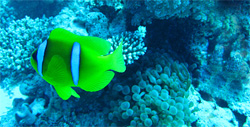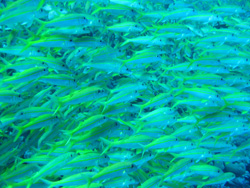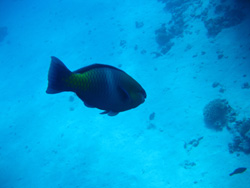Resplendence of the Red Sea
By Shweta Amit | 29 Dec 2010
No one knows why it’s called the Red Sea. Many in fact have mulled over its unique name, and we were no exceptions. This was one reason why we decided to take a plunge into this water body, besides being certified scuba divers. When one thinks about diving in Egypt two places instantly come to the mind, namely Hurghada and Sharm el Sheikh, both located by the Red Sea. We chose to visit Hurghada as it was along our tour route. The Sharm el Sheikh was situated on the other side of the Sinai Peninsula. Hurghada was bustling with activity with an array of shopping centres, restaurants and friendly people. Adding to the charm were shops with attractive posters, which rented out diving equipment.
When one thinks about diving in Egypt two places instantly come to the mind, namely Hurghada and Sharm el Sheikh, both located by the Red Sea. We chose to visit Hurghada as it was along our tour route. The Sharm el Sheikh was situated on the other side of the Sinai Peninsula. Hurghada was bustling with activity with an array of shopping centres, restaurants and friendly people. Adding to the charm were shops with attractive posters, which rented out diving equipment.
Having arranged for equipment from one of the shops, we assembled at the dive centre eagerly awaiting our underwater expedition. After filling in a few formalities, we were onboard the boat with our guide and a few professional scuba divers.
Welcome aboard: The boat was modern, well-furnished and well-equipped with rest rooms, water and soft drinks. The beverages were essential to hydrate ourselves pre and post dives. There was room on the deck to spread out our wet suits, masks, fins and breathing equipment. During the cruise, we were briefed about the dive sites we would be visiting and precautions and signs to be used underwater. It sounded pretty exciting to hear about the aquatic species we would be bumping into during our dives. As we neared the location, we slipped into our scuba diving suits and paired up with our respective diving buddies. Before taking the leap into the rippling waves, we did what was called the ‘buddy check’, ensuring that our partners’ equipment was in place. After which we jumped into the sea, one by one.
The enchanting world below: The temperature of the water was not more than 25 degrees. Being a sunny day and the sea quite calm, the visibility was up to 20m. We descended down slowly as guided and reached the ocean bed. We looked around in amazement and awe at the world that lay beneath the waves. A shoal of goldfish swam past us, and we couldn’t help but notice their beauty and grace. We ventured further, led by our guide, and soon felt no different from the fish when we used our fins. A clown fish spotted in the vicinity led to a ‘finding Nemo’ moment. Keeping an eye on our buddies, we swam further, hoping to spot a shark. We stumbled upon a gigantic moray eel basking at the bottom. Not far from it, we found a blue spotted ray; the sun's rays trickling down highlighting its vivid colour. Further down, we were delighted when a Napoleon wrasse graced us with its presence. This species is huge, and rarely goes unnoticed by divers. We found ourselves caught in mild currents, which we navigated, and were treated to the sight of angel fish. These rectangular blue fish had a patch of yellow on them. The butterfly fish added additional colour to our underwater safari with its bright yellow streamlined body. It was exciting to encounter finned creatures of varied shapes, sizes and colours. Our first dive came to an end and we wistfully headed back to the surface.
Between the dives: On reaching our boat, our dive time recorded was a good  45 minutes. Time seemed to fly faster underwater than on land. We had time to grab a bite before gearing up for our second and last dive for the day. This time the nervousness that was present earlier was replaced by enthusiasm. The Red Sea contains about 38 per cent salt, which is the highest in comparison to other salt water bodies. This increased buoyancy, ie, the ability to remain afloat. After jumping into the waves once again, we descended down to explore a dive site, namely the Aquarium.
45 minutes. Time seemed to fly faster underwater than on land. We had time to grab a bite before gearing up for our second and last dive for the day. This time the nervousness that was present earlier was replaced by enthusiasm. The Red Sea contains about 38 per cent salt, which is the highest in comparison to other salt water bodies. This increased buoyancy, ie, the ability to remain afloat. After jumping into the waves once again, we descended down to explore a dive site, namely the Aquarium.
Feeling like a mermaid: We were introduced to finned species quite different from our first dive. Our tryst began with sighting the orange-spotted unicorn fish. We came across the moray eel lazing behind the rocks. Eels are night predators, hunting down prey. As we moved ahead, we spotted the lizard fish, which appeared unfazed by the crowd of divers around it. Living up to its name, it resembled a lizard and was covered with dark, tough scales. A masked puffer fish which played hard to get close to, swam in its own world, with a black mask over its eyes and mouth. With a mouth shaped like a parrot, the parrot fish was quite flamboyant in its appearance. We were once again graced by the majestic Napoleon wrasse. This time the sea was friendly and we were spared its currents. All good things come to an end; we once again bid farewell to the surreal world.
Back to the shores: We surfaced, got on the boat and headed towards the  shores of Hurghada. It was a memorable return journey over a silky smooth sea with the sunset in the background. We carried back with us treasured memories of the enthralling world of mermaids and mermen. We were lucky enough to be blessed with perfect weather and reliable underwater equipment. As we scanned through the images, I came to the conclusion that the colourful array of species is probably what gave the Red Sea its resplendent name. If anyone wondered what it was like to be a mermaid or merman for some time, diving in the Red Sea, one of the best places to dive in the world, would answer your question.
shores of Hurghada. It was a memorable return journey over a silky smooth sea with the sunset in the background. We carried back with us treasured memories of the enthralling world of mermaids and mermen. We were lucky enough to be blessed with perfect weather and reliable underwater equipment. As we scanned through the images, I came to the conclusion that the colourful array of species is probably what gave the Red Sea its resplendent name. If anyone wondered what it was like to be a mermaid or merman for some time, diving in the Red Sea, one of the best places to dive in the world, would answer your question.
How to get to Hurghada
By air: One can fly to Cairo and board a flight to Hurghada from there. Direct flights to Hurghada are available from European countries and the Middle East.
By road: One can reach Hurghada by driving down from the city of Luxor, which takes roughly about four hours. Direct flights are available from the Middle East and European nations to Luxor.
Best time to visit Hurghada
Hurghada is a year-round destination. However the best period to visit would be between February to April; it is usually pleasant, with the onset of spring, and the sea is perfect for diving. July and August are the hottest months of the year; however, this makes it even more suitable for diving, and the rates in Egypt are usually half around this time, being a lean season.
Cost of diving
The cost of renting equipment for each dive sums up to around Rs10,000 per person. However rates may be subject to variation depending on the dive shop, number of dives or if the person is carrying his / her own scuba diving equipment.
Tips essential for diving
- One needs to get a certification from either Professional Association of Diving Instructors or Scuba Schools International.
- Never dive alone.
- Never dive when you are diagnosed with cold or cough or any infection that affects your breathing.
- Ensure that you are always accompanied by a professional guide.
- Strictly adhere to instructions given on board the boat.
- Always keep an eye on your diving buddy while underwater to ensure you do not get lost.





















